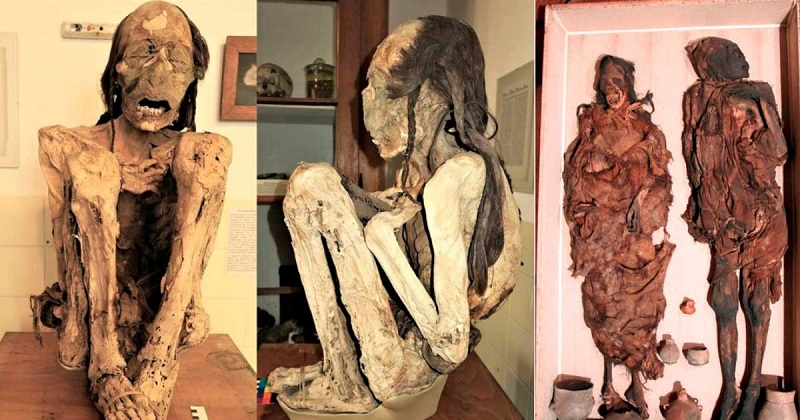There are cold cases, and there a really, really, cold cases. The story of two South American mummies falls into the latter category. When researchers analyzed the remains of three pre-Columbian South American mummies they found two of the individuals were brutally killed. It was time for the scientists to try detective work!
 Analyzing South American Mummies
Analyzing South American Mummies
A new study published in the journal Frontiers in Medicine showcases how a thorough analysis of mummified remains can reveal startling information, even if the remains are up to a thousand years old. The South American mummies the researchers studied are currently in Europe – one is kept at Marburg University in Germany and the other two are in the collection of the Delémont Museum in Switzerland.
The Marburg mummy was originally from the Arica region in Northern Chile and lived sometime between 996 and 1147 AD. While the Delémont mummies, a male and a female, come from the Arequipa region in Peru. The female Delémont mummy has been radiocarbon dated to 1224 and 1282 AD, while the male mummy lived sometime between 902 and 994 AD. All three mummies were naturally mummified.

3D computed tomography scans use X-rays which allowed the researchers to see the internal state of the mummies’ remains without having to open them up. When the researchers used the 3D CT scans on the South American mummies they discovered evidence of pre- and perimortem trauma, as well as post-mortem breaks. Furthermore, their paleo-forensic research shows that both of the male mummies had died from lethal trauma.
Pathologist Andreas Nerlich, from the Munich Clinic Bogenhausen in Germany, says that the brutal deaths of the two South American mummies was only visible because of the bodies’ state of preservation. “Here we show lethal trauma in two out of three South American mummies that we investigated with 3D CT. The types of trauma we found would not have been detectable if these human remains had been mere skeletons.”
Discovering the Brutal Truth of Two Pre-Columbian Murders
The Marburg mummy was 20-25 years old when he was killed. He was buried with textiles, ceramics, and fishing tools – suggesting he was likely part of a fishing community. The scientists found signs of severe tuberculosis on his lungs, but the ‘virtual autopsy’ of the Marburg mummy suggests that he didn’t die from the disease, he was murdered in one of two scenarios.

In their paper, the researchers describe the two scenarios: “one ᴀssaulter hit the victim with full force on the head and [a] second ᴀssaulter stab[bed] the victim (who still was standing or kneeling) in the back. Alternatively, the same or another ᴀssaulter standing on the right side of the victim struck the head and then turned to the back of the victim and stabbed him.”
The researchers write that their analysis of the male Delémont mummy shows the man had “mᴀssive trauma against the cervical spine which represents most likely the cause of death” – meaning he was killed by a fatal blow to the back of his neck.
Signs of Trauma on All Three South American Mummies
All three of the South American mummies had signs of trauma, however the researchers state that they believe only the males had been violently killed. The female Delémont mummy had suffered damage to the skeleton, but this is believed to have happened when her body was buried.
‘Bone Collector’ Sleuth Says Violent Deaths Evident in Mᴀss Grave Under Irish Bar!
Ten Incredible Mummy Discoveries That Shocked the World
The scientists also believe that some of the postmortem damages found on all three bodies were due to excavations or transportation of the mummies. Nerlich expressed graтιтude for the non-destructive and effective technology the research team now has at their disposal when studying the pre-Columbian mummies, saying:
“The availability of modern CT scans with the opportunity for 3D reconstructions offers unique insight into bodies that would otherwise not have been detected. Previous studies would have either destroyed the mummy, while x-rays or older CT scans without three-dimensional reconstruction functions could not have detected the diagnostic key features we found here.”

Gaining Significant Insight on a Violent Past
Nerlich also notes that studying mummified remains “can reveal a much higher rate of trauma, especially intentional trauma, than the study of skeletons.” He suggests that “There are dozens of South American mummies which might profit from a similar investigation as we did here.”
While the evidence of the violent deaths of the two men is disturbing, it isn’t surprising. A 2021 study on the rate of violence in a pre-Columbian horticulturist population of Northern Chile found evidence of trauma from violence in 21% of the human remains belonging to males.
These studies are not entertaining or pleasant but learning about these types of death and violence do provide useful insight on how people lived, got along (or not), and died in these regions in the past.





